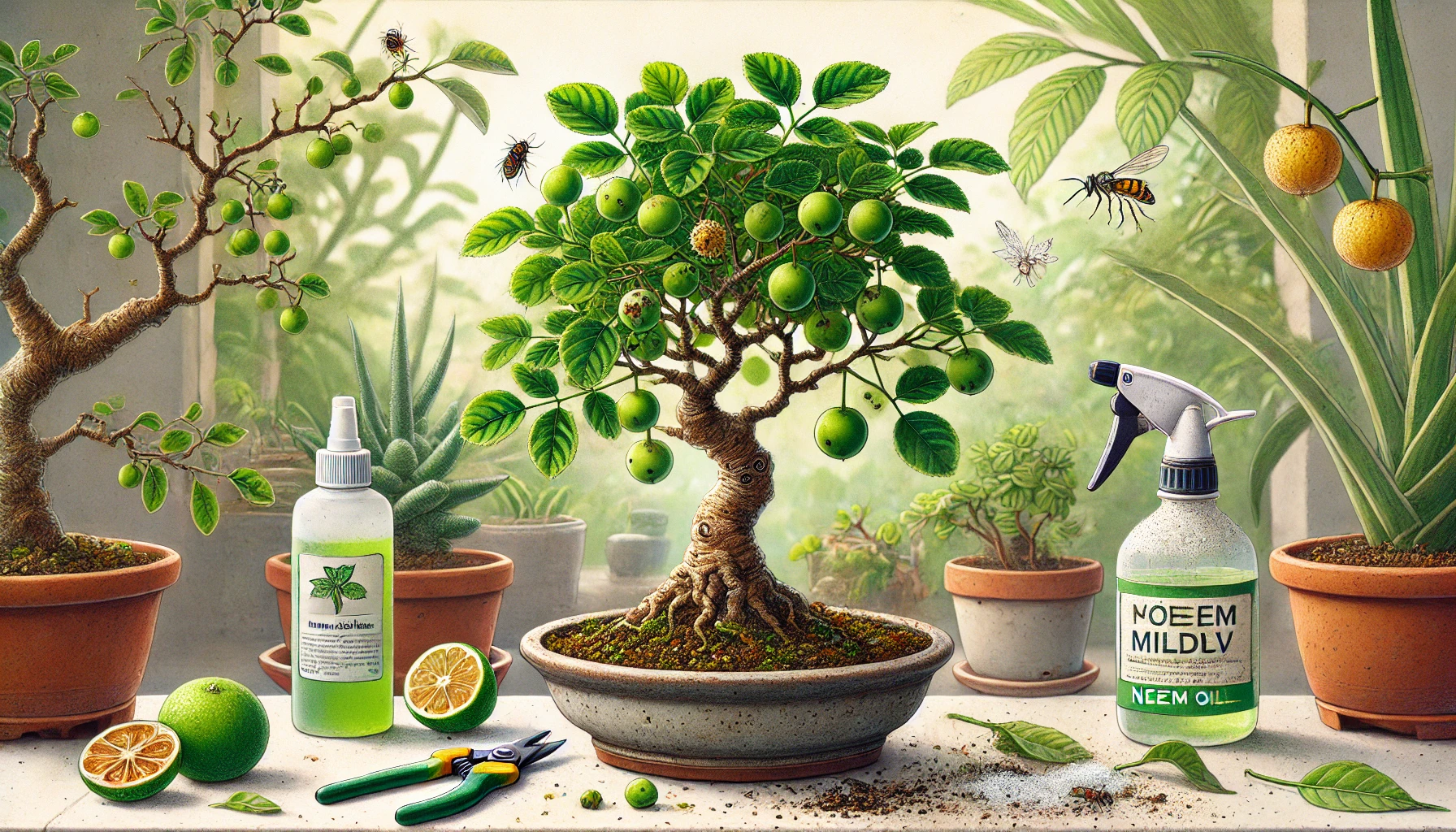Fruiting bonsai trees are stunning additions to any collection, but their compact size and unique growing conditions can make them vulnerable to pests and diseases. Understanding how to identify and address these issues is crucial to maintaining a healthy and thriving bonsai. This comprehensive guide covers the most common pests and diseases that affect fruiting bonsai trees and provides actionable steps to combat them.
Why Fruiting Bonsai Are Susceptible to Pests and Diseases
The unique care requirements of bonsai trees, such as shallow pots, limited soil, and indoor growing environments, create conditions that can sometimes stress the plant. Stress weakens the tree’s natural defenses, making it more susceptible to pests and diseases.
Factors that contribute to vulnerabilities include:
- Overwatering or Underwatering: Improper watering can weaken the root system.
- Poor Air Circulation: Stagnant air around the tree encourages fungal growth and pests.
- Improper Fertilization: Nutrient deficiencies or over-fertilization can stress the tree.
Common Pests in Fruiting Bonsai
Aphids
Symptoms:
- Clusters of small, soft-bodied insects on new growth and undersides of leaves.
- Sticky residue (honeydew) on leaves and branches.
- Distorted or curled leaves.
How to Combat:
- Remove aphids manually with a soft cloth or spray them off with water.
- Apply neem oil or insecticidal soap to affected areas.
- Introduce beneficial insects like ladybugs to naturally reduce aphid populations.
Spider Mites
Symptoms:
- Fine webbing on leaves and branches.
- Yellow or brown speckles on leaves.
- Dry, brittle foliage.
How to Combat:
- Increase humidity by misting the tree regularly.
- Use a strong jet of water to dislodge mites.
- Treat with miticides or horticultural oil if the infestation is severe.
Scale Insects
Symptoms:
- Hard or soft bumps on stems and leaves that resemble small shells.
- Yellowing leaves and sticky honeydew residue.
- A weakened, declining tree.
How to Combat:
- Scrape off scales gently with a cotton swab dipped in alcohol.
- Apply horticultural oil to smother eggs and larvae.
- Repeat treatments weekly to break the pest lifecycle.
Mealybugs
Symptoms:
- White, cotton-like clusters on stems and leaf nodes.
- Stunted growth and sticky honeydew.
How to Combat:
- Dab mealybugs with a cotton swab dipped in alcohol.
- Spray neem oil or insecticidal soap on infested areas.
- Quarantine the tree to prevent the spread to other plants.
Whiteflies
Symptoms:
- Tiny white insects flying around the tree when disturbed.
- Yellowing or dropping leaves.
- Sticky honeydew residue.
How to Combat:
- Use yellow sticky traps to capture adult whiteflies.
- Spray insecticidal soap or neem oil directly on the insects.
- Remove heavily infested leaves.
Common Diseases in Fruiting Bonsai
Root Rot
Cause: Overwatering or poorly draining soil.
Symptoms:
- Wilting leaves despite adequate watering.
- Black, mushy roots with a foul odor.
- Stunted growth or sudden decline.
How to Combat:
- Remove the bonsai from its pot and trim away affected roots.
- Repot in fresh, well-draining soil.
- Adjust watering habits to allow the soil to dry slightly between waterings.
Powdery Mildew
Cause: High humidity and poor air circulation.
Symptoms:
- White, powdery patches on leaves and stems.
- Leaf curling and premature leaf drop.
How to Combat:
- Increase airflow around the bonsai by spacing it away from other plants.
- Spray affected areas with a mixture of water and baking soda (1 teaspoon per liter of water).
- Apply fungicides if the infection persists.
Leaf Spot
Cause: Fungal or bacterial infection, often due to wet foliage.
Symptoms:
- Brown or black spots on leaves.
- Yellowing leaves that eventually fall off.
How to Combat:
- Remove and dispose of infected leaves to prevent the spread.
- Avoid overhead watering and wetting the foliage.
- Treat with fungicides designed for leaf spot diseases.
Rust
Cause: Fungal spores thriving in moist environments.
Symptoms:
- Orange or rust-colored spots on the underside of leaves.
- Premature leaf drop.
How to Combat:
- Prune affected leaves and dispose of them away from the bonsai area.
- Improve air circulation by thinning out the foliage.
- Apply a sulfur-based fungicide to infected areas.
Citrus Canker (For Citrus Bonsai)
Cause: Bacterial infection.
Symptoms:
- Raised, corky lesions on leaves, stems, and fruits.
- Yellow halo around the lesions.
How to Combat:
- Prune and dispose of infected branches.
- Sterilize pruning tools after each cut to prevent further spread.
- Apply copper-based bactericides to manage the infection.
Preventive Measures for Pest and Disease Control
Regular Inspection
- Examine your bonsai closely at least once a week.
- Look for early signs of pests or diseases, such as discoloration, webbing, or unusual growths.
Proper Watering
- Avoid overwatering, which can create conditions for root rot and fungal diseases.
- Water only when the soil’s top layer feels dry.
Improve Air Circulation
- Place your bonsai in a well-ventilated area.
- Space bonsai trees apart to reduce the risk of fungal infections spreading.
Maintain Cleanliness
- Remove fallen leaves, fruits, or debris from the soil surface.
- Clean pots, tools, and workspaces regularly to minimize contamination.
Use Natural Remedies
- Spray neem oil as a preventive measure against pests.
- Introduce beneficial insects to maintain a balanced ecosystem.
When to Seek Professional Help
If your bonsai shows severe symptoms despite your efforts, consider consulting a bonsai specialist or horticulturist. Professional advice can help diagnose complex issues and provide tailored solutions.
Caring for a fruiting bonsai is a fulfilling experience, but it requires vigilance and proactive care to combat pests and diseases. By learning to identify and address problems early, you can ensure your bonsai remains healthy, vibrant, and productive for years to come.

